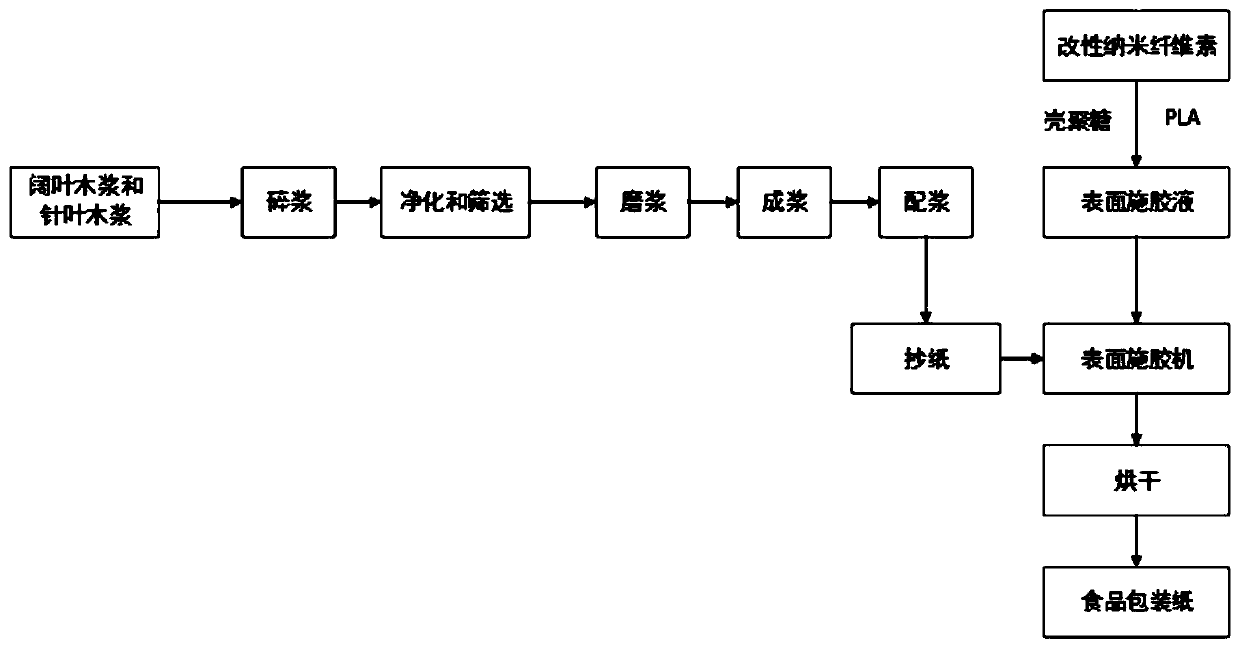Fluorine-contained hydrophobic oil-proof modified nanocellulose for food packaging paper and preparation method of nanocellulose
A technology of nanocellulose and food wrapping paper, applied in the directions of wrapping paper, wrapping paper, packaging, etc., can solve the problems of harming food, reducing physical strength, hidden dangers, etc., to improve physical properties, improve oxygen barrier, good film formation sexual effect
- Summary
- Abstract
- Description
- Claims
- Application Information
AI Technical Summary
Problems solved by technology
Method used
Image
Examples
Embodiment 1
[0033] A method for preparing a fluorine-containing hydrophobic and oil-resistant modified nanocellulose for food wrapping paper according to this embodiment, the method specifically includes the following steps:
[0034] (1) First, add water to the purchased nanocellulose (made by TEMPO oxidation-mechanical treatment of softwood pulp fibers) to prepare a 1.5% nanocellulose suspension, and put 1.5% nanocellulose in the reactor The aqueous suspension was evaporated so that the suspension became gel-like. Add dispersant N-N-dimethylformamide and gelatinous nanocellulose into another reactor according to the ratio, mix well, then keep stirring at constant temperature in the reactor for 6 hours at 85°C, then add trifluoroacetic acid anhydride and 4-dimethylaminopyridine (the mass ratio of nanocellulose, trifluoroacetic anhydride, and 4-dimethylaminopyridine is 1:50:2.0), then disperse for 20 minutes, and raise the temperature to 100°C. After 6 hours of reaction Cool for 30 minute...
Embodiment 2
[0037] A method for preparing a fluorine-containing hydrophobic and oil-resistant modified nanocellulose for food wrapping paper according to this embodiment, the method specifically includes the following steps:
[0038] (1) First, add water to the purchased nanocellulose (made by TEMPO oxidation-mechanical treatment of softwood pulp fibers) to prepare a 1% nanocellulose suspension, and put 1% nanocellulose in the reactor The aqueous suspension was evaporated so that the suspension became gel-like. Add dispersant N-N-dimethylformamide and gelatinous nanocellulose into another reactor according to the ratio, mix well, then keep stirring in the reactor at constant temperature for 3 hours at 90°C, and then add trifluoroacetic acid anhydride and 4-dimethylaminopyridine (the mass ratio of nanocellulose, trifluoroacetic anhydride, and 4-dimethylaminopyridine is 1:50:1.0), then disperse for 15 minutes, and raise the temperature to 100°C, and react for 5 hours Cool for 30 minutes, a...
Embodiment 3
[0041] A method for preparing a fluorine-containing hydrophobic and oil-resistant modified nanocellulose for food wrapping paper according to this embodiment, the method specifically includes the following steps:
[0042] (1) First, add water to the purchased nanocellulose (made by TEMPO oxidation-mechanical treatment of softwood pulp fibers) to prepare a 1.2% nanocellulose suspension, and 1.2% nanocellulose in the reactor The aqueous suspension was evaporated so that the suspension became gel-like. Add dispersant N-N-dimethylformamide and gelatinous nanocellulose into another reactor according to the ratio, mix well, then keep stirring in the reactor at constant temperature for 4 hours at 90°C, and then add trifluoroacetic acid anhydride and 4-dimethylaminopyridine (the mass ratio of nanocellulose, trifluoroacetic anhydride, and 4-dimethylaminopyridine is 1:50:0.5), then disperse for 10 minutes, and raise the temperature to 100°C, and react for 3 hours Cool for 30 minutes, a...
PUM
| Property | Measurement | Unit |
|---|---|---|
| Water absorption | aaaaa | aaaaa |
Abstract
Description
Claims
Application Information
 Login to View More
Login to View More - R&D
- Intellectual Property
- Life Sciences
- Materials
- Tech Scout
- Unparalleled Data Quality
- Higher Quality Content
- 60% Fewer Hallucinations
Browse by: Latest US Patents, China's latest patents, Technical Efficacy Thesaurus, Application Domain, Technology Topic, Popular Technical Reports.
© 2025 PatSnap. All rights reserved.Legal|Privacy policy|Modern Slavery Act Transparency Statement|Sitemap|About US| Contact US: help@patsnap.com



